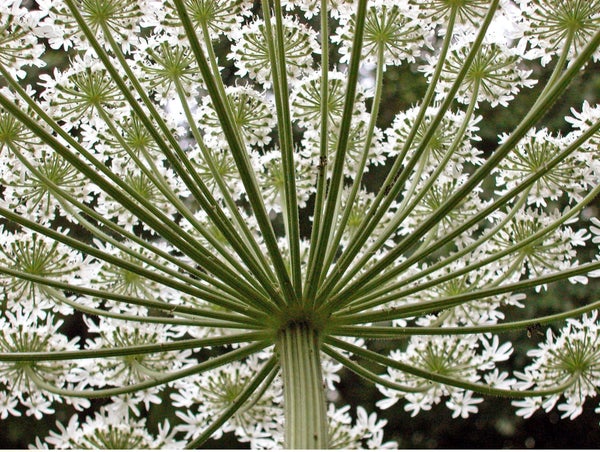Plants might seem like pacifists, but they can launch devastating chemical attacks against their foes. One such warmonger is giant hogweed, an invasive plant whose sap triggers blistering burns when it contacts human skin—but only if the plant’s toxins are activated by sunlight. Giant hogweed’s defense strategy has evoked a mix of fear and morbid curiosity as the plant conquers new territory across North America.
Giant hogweed is native to the Caucasus Mountains and central Asia, but was brought to New York City as a garden adornment in 1917. Wild populations have since cropped up across North America. In June Virginia became the 12th state, along with four Canadian provinces, known to harbor the pest. Researchers from Virginia Polytechnic Institute announced the discovery of 30 hogweed plants lurking in local gardens.
“It’s essentially trying to punish animals for eating it,” says Jordan Metzgar, who curates Virginia Tech’s Massey Herbarium and helped identify the state’s newest invasive plant. But humans can also suffer gruesome burns if they touch the hogweed’s toxin-bearing sap. The news sparked panic throughout Virginia and online over the toxin produced by giant hogweed. If the noxious substance, from a family of compounds called furocoumarins, get into skin cells, they can destroy the body’s most precious molecules—DNA—with help from the sun.
On supporting science journalism
If you're enjoying this article, consider supporting our award-winning journalism by subscribing. By purchasing a subscription you are helping to ensure the future of impactful stories about the discoveries and ideas shaping our world today.
DNA consists of a set of four compounds called bases, akin to letters of the alphabet. But giant hogweed’s toxins can scramble this language of life when activated by sunlight, says Ock Chun, a nutritional scientist who studies furocoumarins at the University of Connecticut. The sun’s ultraviolet rays excite electrons in furocoumarin molecules, causing them to bind to two of the DNA bases—thymine and cytosine. This binding inhibits vital cellular functions like copying DNA into RNA and creating proteins, and can distort the base sequence, according to Chun. The skin cells die as a result, producing a burn that blisters and peels. Medical journals label this condition “phytophotodermatitis,” a mash-up of the ancient Greek words for plant, light, skin and inflammation. If giant hogweed sap gets into the eyes, it can trigger the same burning process, temporarily impairing vision. Some studies list blindness as a possible effect, but medical cases describing this outcome are scarce.
Despite their dangers, furocoumarins’ caustic properties are sometimes harnessed to treat psoriasis and other skin ailments, according to Chun. Patients take the compounds either by mouth or via direct application to the skin. Doctors then kill the affected skin cells with a targeted blast of ultraviolet light, halting the disease’s spread. Chun warns patients should limit their sun exposure following treatment to avoid damaging healthy skin cells.
For anyone who accidentally touches giant hogweed, Metzgar advises thoroughly rinsing their skin with cold water and soap to wash away the furocoumarins before they penetrate skin cells. If that’s not possible, covering up the exposure site and avoiding sun or other ultraviolet light exposure for a couple of days can stop furocoumarins from binding to DNA, preventing a burn.
Virginia plans to remove the recently discovered invasives to “stamp out any populations before they become established,” Metzgar says. As for states where giant hogweed is already widespread, he cautions bushwhacking hikers and children playing in vegetation that they risk exposure to the plant. Chopping down giant hogweed with a weed trimmer is likely to only spread the sap, according to Metzgar. Instead, he recommends reporting potential sightings of the plant to authorities such as state natural resource agencies.
Although giant hogweed has grabbed headlines, other plants produce furocoumarins, too. Relatives of the weed, including the invasive wild parsnip and the native cow parsnip, contain such toxins in their saps, albeit at lower concentrations than giant hogweed. Furocoumarins are even found in some citrus fruits such as grapefruit, lemon and lime. A study in 2014 noted the high prevalence of phytophotodermatitis among bartenders, who squeeze citrus fruits into mixed drinks dozens of times per work shift.
Metzgar says he is not aware of injuries caused by the giant hogweed plants in Virginia. But given the severe burns sustained by people elsewhere in the plant’s range, he urged residents to be wary of this new invader.
